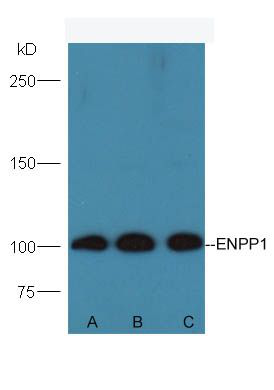产品货号 : mlR4913
英文名称 : ENPP1
中文名称 : 核苷酸内焦磷酸酶/磷酸二酯酶1抗体
别 名 : Alkaline phosphodiesterase 1; ARHR2; E-NPP 1; Ectonucleotide pyrophosphatase/phosphodiesterase 1; Ectonucleotide pyrophosphatase/phosphodiesterase family member 1; ENPP1_HUMAN; Ly 41 antigen; M6S1; Membrane component chromosome 6 surface marker 1; NPP1; NPPase; NPPS; Nucleotide pyrophosphatase; PC-1; PCA1; PDNP1; Phosphodiesterase I/nucleotide pyrophosphatase 1; Plasma cell membrane glycoprotein 1; Plasma-cell membrane glycoprotein PC-1.
研究领域 : 肿瘤 免疫学 信号转导 激酶和磷酸酶
抗体来源 : Rabbit
克隆类型 : Polyclonal
交叉反应 : Human, Mouse, Rat, Dog, Pig, Horse, Rabbit,
产品应用 : WB=1:500-2000 ELISA=1:500-1000 IHC-F=1:400-800 ICC=1:100-500 IF=1:100-500 (石蜡切片需做抗原修复)
not yet tested in other applications.
optimal dilutions/concentrations should be determined by the end user.
分 子 量 : 100kDa
细胞定位 : 细胞浆 细胞膜
性 状 : Lyophilized or Liquid
浓 度 : 1mg/ml
免 疫 原 : KLH conjugated synthetic peptide derived from human ENPP1:41-140/925 <Extracellular>
亚 型 : IgG
纯化方法 : affinity purified by Protein A
储 存 液 : 0.01M TBS(pH7.4) with 1% BSA, 0.03% Proclin300 and 50% Glycerol.
保存条件 : Store at -20 °C for one year. Avoid repeated freeze/thaw cycles. The lyophilized antibody is stable at room temperature for at least one month and for greater than a year when kept at -20°C. When reconstituted in sterile pH 7.4 0.01M PBS or diluent of antibody the antibody is stable for at least two weeks at 2-4 °C.
PubMed : PubMed
产品介绍 : ENPP1 has a broad specificity and cleaves a variety of substrates, including phosphodiester bonds of nucleotides and nucleotide sugars and pyrophosphate bonds of nucleotides and nucleotide sugars. It can hydrolyze nucleoside 5' triphosphates such as ATP, GTP, CTP, TTP and UTP to their corresponding monophosphates with release of pyrophosphate. It can also hydrolyze diadenosine polyphosphates and 3',5'-cAMP to AMP. It may play a role in the regulation of pyrophosphate production, the regulation of the availability of nucleotide sugars in the endoplasmic reticulum and Golgi, and the regulation of purinergic signaling.
Function:
Involved primarily in ATP hydrolysis at the plasma membrane. Plays a role in regulating pyrophosphate levels, and functions in bone mineralization and soft tissue calcification. In vitro, has a broad specificity, hydrolyzing other nucleoside 5' triphosphates such as GTP, CTP, TTP and UTP to their corresponding monophosphates with release of pyrophosphate and diadenosine polyphosphates, and also 3',5'-cAMP to AMP. May also be involved in the regulation of the availability of nucleotide sugars in the endoplasmic reticulum and Golgi, and the regulation of purinergic signaling. Appears to modulate insulin sensitivity.
Subunit:
In general heterodimer of an alpha and a beta chain linked by two disulfide bonds.
Subcellular Location:
Membrane; Single-pass type II membrane protein. Basolateral cell membrane; Single-pass type II membrane protein. Note=Targeted to the basolateral membrane in polarized epithelial cells and in hepatocytes, and to matrix vesicles in osteoblasts. In bile duct cells and cancer cells, located to the apical cytoplasmic side.
Tissue Specificity:
Expressed in plasma cells and also in a number of non-lymphoid tissues, including the distal convoluted tubule of the kidney, chondrocytes and epididymis.
Post-translational modifications:
Autophosphorylated as part of the catalytic cycle of phosphodiesterase/pyrophosphatase activity.
N-glycosylated.
It has been suggested that the active SMB domain may be permitted considerable disulfide bond heterogeneity or variability, thus two alternate disulfide patterns based on 3D structures are described with 1 disulfide bond conserved in both.
DISEASE:
Defects in ENPP1 are a cause of increased susceptibility for ossification of the posterior longitudinal ligament of the spine (OPLL) [MIM:602475]. OPLL is a common form of human myelopathy with a prevalence of as much as 4% in a variety of ethnic groups.
Defects in ENPP1 are a cause of idiopathic infantile arterial calcification (IIAC) [MIM:208000]; also known as generalized arterial calcification of infancy. IIAC is characterized by calcification of the internal elastic lamina of muscular arteries and stenosis due to myointimal proliferation.
Defects in ENPP1 are associated with obesity, glucose intolerance, and type II diabetes non-insulin dependent (NIDDM)[MIM:125853].
Similarity:
Belongs to the nucleotide pyrophosphatase/phosphodiesterase family.
Contains 2 SMB (somatomedin-B) domains.
SWISS:
P22413
Gene ID:
5167
Important Note:
This product as supplied is intended for research use only, not for use in human, therapeutic or diagnostic applications.
产品图片












